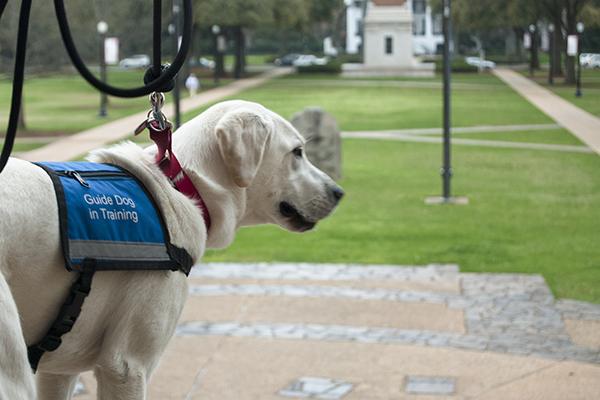Tara King graduated from The University of Alabama in 2013 with a master’s degree in social work. While she was here, she had her service dog Libra by her side.
Libra came from Guide Dogs for the Blind, a charitable organization based in San Rafael, California. King said she wanted to go through an organization rather than a private trainer.
“A lot of times when you go through an institution, at least with Guide Dogs for the Blind, everything is free to the consumer,” she said. “On top of that, now that I have Libra, as long as I need to, they will pay for her vet care.”
Guide Dogs for the Blind covered the training of the dog, the cost of the dog itself and King’s travel expenses to and from the Guide Dogs for the Blind along with her room and board while she was in training with Libra.
King said the biggest adjustment when she first got Libra was remembering to keep the dog with her at all times. When she gets up to go somewhere, she grabs her purse, and she grabs Libra.
“She’s almost like having a kid,” King said. “She’s with me 24/7. Where I go, she goes. Period.”
King and Libra went through training together at the Guide Dogs for the Blind headquarters, but King said she makes sure to keep Libra’s skills sharp.
“Every day, I’ll test her by throwing down a Kleenex or by throwing down a piece of bacon or kibble and make sure that she’s still ignoring it,” King said. “As long as I consistently work her, that’s ongoing training in and of itself.”
King said having a service dog didn’t necessarily influence her decision to go into social work, but she expects having a service dog will aid in her work. She knows several other social workers who have service dogs who have found them to break down awkward barriers.
“Service dogs come in handy a lot, because dogs, especially if they’re mild mannered, they just open up doors of communication so much easier and so much quicker than anything else,” King said. “I know with kids especially, they’ll open up so much quicker to a dog than they will a person, so that helps.”
King said she never ran into any trouble having Libra on campus, but she said she wished more people knew the proper rules of engaging with a service animal.
“I wish people understood that when they see a dog with a harness or a vest or anything that denotes ‘this is a service animal’ no matter what the kind, when they are working please do not call out to the dog, please do not reach out and pet the dog without asking the human,” she said. “Because when they do that, when they distract the dog from working, it endangers the handler.”
Judy Thorpe, the director of the Office of Disability Services, said the University doesn’t have very many restrictions on the use of service dogs on campus. The Americans with Disabilities Act has clear regulations on where the animals must be allowed and where they can be restricted.
“Generally speaking, the University allows service animals assisting individuals with disabilities in all facilities and programs on campus that are open to the public or to students with a few exceptions,” she said. “Service animals may be excluded in areas where the presence of the animal fundamentally alters the nature of a program or activity or presents a safety hazard.”
Thorpe said because students are encouraged but not required to register with ODS, the University doesn’t have accurate statistics on the use of guide dogs on campus.
“Service dogs are not limited to only those with visual impairments but may be trained to assist people with all kinds of disabilities, including hearing impairments, seizure disorders, diabetes, PTSD and mobility impairments,” Thorpe said.
Russell Timkovich, a chemistry professor at the University, raises puppies to be service dogs for Southeastern Guide Dogs, a group similar to Guide Dogs for the Blind. AJ, a yellow goldador, sleeps under his desk in his office and under the lectern in his classes.
“Most of the time she’s on a tie down, and she just sits here, she’s got a little chew toy and she just naps,” Timkovich said.
Timkovich said the training AJ is going through now is less complex than what she’ll get before she’s paired with a client, but it’s still important. AJ is learning to be calm around people, as well as some basic skills for operating in the world.
“We don’t just walk through doors, we have to do it a special way,” Timkovich said “We don’t climb stairs, we do it a special way.”
In May, Timkovich will have to take AJ back to Southeastern Guide Dogs for the last part of her training. He said the process mirrors a parent dropping their child off at college for the first time.
“They call it ‘University Days’ because it’s actually done like freshman showing up for orientation,” Timkovich said.
Timkovich said he’s not looking forward to giving AJ up. After University Days, the puppy raisers only have the opportunity to see the dog one more time at the dog’s graduation with the client.
Once the dog starts its career with a client, the puppy handler isn’t allowed to interfere with the work. When the dog is 10 or 12 years old, Southeastern retires them and pairs the client with a new animal.
“They are offered back to the original puppy raiser to life out its life as a family pet,” Timkovich said. “If the original raiser doesn’t want to do that, then there is a public adoption scheme, and believe me the waiting list for these dogs is far, far longer than the dogs themselves.”









